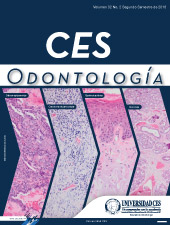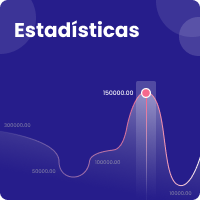El potencial terapéutico del secretoma de las células troncales
DOI:
https://doi.org/10.21615/cesodon.31.2.4Palabras clave:
Células troncales mesenquimales, Ingeniería tisular, Secretoma, InmunomodulaciónResumen
Las células madre -o troncales- mesenquimales (CTMs) juegan un papel importante en medicina regenerativa e ingeniería tisular, puesto que estas células indiferenciadas tienen la capacidad de autorrenovarse y de diferenciarse en varios linajes celulares adultos con funciones especializadas diferentes. Estas células cuentan con la capacidad de inmunomodulación y establecimiento celular sin riesgo de generar teratomas, en contraste con las células troncales embrionarias o las células troncales pluripotenciales inducidas. Varios autores también resaltan la capacidad regenerativa de los productos de estas células, conocido como secretoma. Estos productos juegan un papel muy importante en procesos de cicatrización y angiogénesis, por lo que resultan ideales para aplicarlos en terapias basadas en regeneración y reparación de tejidos y órganos. La presente revisión hace un recuento del estado del arte sobre los procesos de inmunomodulación producidos a partir de estos productos celulares.
Descargas
Referencias bibliográficas
Friedenstein AJ, Deriglasova UF, Kulagina NN, Panasuk AF, Rudakowa SF, Luriá EA, et al. Precursors for fibroblasts in different populations of hematopoietic cells as detected by the in vitro colony assay method. Experimental Hematology 1974;2(2):83-92.
Zhao Q, Ren H, Han Z. Mesenchymal stem cells: Immunomodulatory capability and clinical potential in immune diseases. Journal of Cellular Immunotherapy (2015), http://dx.doi.org/10.1016/j.jocit.2014.12.001
Egusa H, Sonoyama W, Nishimura M, Atsuta I, Akiyama K. Stem cells in dentistry--part I: stem cell sources. Journal of Prosthodontic Research 2012 July;56(3):151-165.
Rodrigues CAV, Fernandes TG, Diogo MM, da Silva CL, Cabral JMS. Stem cell cultivation in bioreactors. Biotechnology Advances 2011;29(6):815-829.
Dominici M, Le Blanc K, Mueller I, Slaper-Cortenbach I, Marini F, Krause D, et al. Minimal criteria for defining multipotent mesenchymal stromal cells. The International Society for Cellular Therapy position statement. Cytotherapy 2006;8(4):315-317.
H. Skalnikova, J. Motlik, S.J. Gadher, H. Kovarova, Mapping of the secretome of primary isolates of mammalian cells, stem cells and derived cell lines, Proteomics 11 (2011) 691–708.
Rastegar F, Shenaq D, Huang J, Zhang W, Zhang BQ, He BC, et al. Mesenchymal stem cells: Molecular characteristics and clinical applications. World journal of stem cells. 2010;2(4):67-80. Epub 2011/05/25. doi: 10.4252/wjsc.v2.i4.67. PubMed PMID: 21607123; PubMed Central PMCID: PMC3097925.
Friedenstein AJ, Gorskaja JF, Kulagina NN. Fibroblast precursors in normal and irradiated mouse hematopoietic organs. Experimental hematology. 1976;4(5):267-74. Epub 1976/09/01. PubMed PMID: 976387.
Gronthos S, Mankani M, Brahim J, Robey PG, Shi S. Postnatal human dental pulp stem cells (DPSCs) in vitro and in vivo. Proceedings of the National Academy of Sciences of the United States of America. 2000;97(25):13625-30. Epub 2000/11/23. doi: 10.1073/pnas.240309797. PubMed PMID: 11087820; PubMed Central PMCID: PMC17626.
Gronthos S, Brahim J, Li W, Fisher LW, Cherman N, Boyde A, et al. Stem cell properties of human dental pulp stem cells. Journal of dental research. 2002;81(8):531-5. Epub 2002/07/31. PubMed PMID: 12147742.
Miura M, Gronthos S, Zhao M, Lu B, Fisher LW, Robey PG, et al. SHED: stem cells from human exfoliated deciduous teeth. Proceedings of the National Academy of Sciences of the United States of America. 2003;100(10):5807-12. Epub 2003/04/30. doi: 10.1073/pnas.0937635100. PubMed PMID: 12716973; PubMed Central PMCID: PMC156282.
Iohara K, Zheng L, Ito M, Tomokiyo A, Matsushita K, Nakashima M. Side population cells isolated from porcine dental pulp tissue with self-renewal and multipotency for dentinogenesis, chondrogenesis, adipogenesis, and neurogenesis. Stem Cells. 2006;24(11):2493-503. Epub 2006/07/29. doi: 10.1634/stemcells.2006-0161. PubMed PMID: 16873765.
Laino G, Carinci F, Graziano A, d'Aquino R, Lanza V, De Rosa A, et al. In vitro bone production using stem cells derived from human dental pulp. The Journal of craniofacial surgery. 2006;17(3):511-5. Epub 2006/06/14. PubMed PMID: 16770190.
Shi S, Bartold PM, Miura M, Seo BM, Robey PG, Gronthos S. The efficacy of mesenchymal stem cells to regenerate and repair dental structures. Orthodontics & craniofacial research. 2005;8(3):191-9. Epub 2005/07/19. doi:10.1111/j.16016343.2005.00331.x. PubMed PMID: 16022721.
Makridakis M, Roubelakis MG, Vlahou A. 2013. Stem cells: insights into the secretome. Biochim Biophys Acta. Nov;1834(11):2380-2384.
Wong, C.E., Paratore, C., Dours-Zimmermann, M.T., Rochat, A., Pietri, T., Suter, U., Zimmermann, D.R., Dufour, S., Thiery, J.P., Meijer, D., Beermann, F., Barrandon, Y.,Sommer, L., 2006. Neural crest-derived cells with stem cell features can be traced back to multiple lineages in the adult skin. J. Cell Biol. 175, 1005-1015.
Tomita, Y., Matsumura, K., Wakamatsu, Y., Matsuzaki, Y., Shibuya, I., Kawaguchi, H.,Ieda, M., Kanakubo, S., Shimazaki, T., Ogawa, S., Osumi, N., Okano, H., Fukuda, K., 2005. Cardiac neural crest cells contribute to the dormant multipotent stem cell in the mammalian heart. J. Cell Biol. 170, 1135–1146.
Yoshida, S., Shimmura, S., Nagoshi, N., Fukuda, K., Matsuzaki, Y., Okano, H., Tsubota, K., 2006. Isolation of multipotent neural crest-derived stem cells from the adult mouse cornea. Stem Cells 24, 2714–2722
Nagoshi, N., Shibata, S., Kubota, Y., Nakamura, M., Nagai, Y., Satoh, E., Morikawa, S., Okada, Y., Mabuchi, Y., Katoh, H., Okada, S., Fukuda, K., Suda, T., Matsuzaki, Y., Toyama, Y., Okano, H., 2008. Ontogeny and multipotency of neural crest- derived stem cells in mouse bone marrow, dorsal root ganglia, and whisker pad. Cell Stem Cell 2, 392–403.
Drago D, Cossetti C, Iraci N, Gaude E, Musco G, Bachi A, Pluchino S. 2013. The stem cell secretome and its role in brain repair. Biochimie. July; 95: 2271-2285
Lavoie JR, Rosu-Myles M. 2013. Uncovering the secrets of mesenchymal stem cells. Biochimie. June; 95:2212-2221.
Lau TT, Wang DA. Stromal cell-derived factor-1 (SDF-1): homing factor for engineered regenerative medicine. Expert opinion on biological therapy. 2011;11(2):189-97.
Arai F, Hirao A, Ohmura M, Sato H, Matsuoka S, Takubo K, et al. Tie2/angiopoietin-1 signaling regulates hematopoietic stem cell quiescence in the bone marrow niche. Cell. 2004;118(2):149-61.
Klimanskaya I, Rosenthal N, Lanza R. 2008. Derive and conquer: sourcing and differentiating stem cells for therapeutic applications, Nat. Rev. Drug Discov. 7 131–142.
H. Skalnikova, J. Motlik, S.J. Gadher, H. Kovarova, Mapping of the secretome of primary isolates of mammalian cells, stem cells and derived cell lines, Proteomics 11 (2011) 691–708.
S.R. Baglio, D.M. Pegtel, N. Baldini, Mesenchymal stem cell secreted vesicles provide novel opportunities in (stem) cell-free therapy, Front. Physiol. 3 (2012) 359.
Van Velthoven CT, Kavelaars A, Heijnen CJ. Mesenchymal stem cells as a treatment for neonatal ischemic brain damage, Pediatr. Res. 71 (2012) 474–481.
Makridakis M, Vlahou A. Secretome proteomics for discovery of cancer biomarkers, J. Proteomics 73 (2010) 2291–2305.
Zilka N, Zilkova M, Kazmerova Z, Sarissky M, Cigankova V, Novak M. Mesenchymal stem cells rescue the Alzheimer's disease cell model from cell death induced by misfolded truncated tau, Neuroscience 193 (2011) 330–337.
Pluchino S, Zanotti L, Rossi B, Brambilla E, Ottoboni L, Salani G, Martinello M, Cattalini A, Bergami A, Furlan R, Comi G, Constantin G, Martino G. Neurosphere-derived multipotent precursors promote neuroprotection by an immunomodulatory mechanism, Nature 436 (2005) 266-271.
Uccelli A, A. Laroni, M.S. Freedman, Mesenchymal stem cells for the treatment of multiple sclerosis and other neurological diseases, Lancet Neurol. 10 (2011) 649-656.
Pluchino S, Cossetti C. How stem cells speak with host immune cells in inflammatory brain diseases, Glia (2013).
Lees JS, Sena ES, Egan KJ, Antonic A, Koblar SA, Howells DW, Macleod MR, Stem cell-based therapy for experimental stroke: a systematic review and meta-analysis, Int. J. Stroke 7 (2012) 582-588.
De Feo D, Merlini A, Laterza C, Martino G. Neural stem cell transplantation in central nervous system disorders: from cell replacement to neuroprotection, Curr. Opin. Neurol. (2012) 322-333. 25.
Pluchino S, Martino G. The therapeutic plasticity of neural stem/precursor cells in multiple sclerosis, J. Neurol. Sci. 265 (2008) 105-110.
Di Nicola M, Carlo-Stella C, Magni M, Milanesi M, Longoni PD, Matteucci P, Grisanti S, Gianni AM. Human bone marrow stromal cells suppress Tlymphocyte proliferation induced by cellular or nonspecific mitogenic stimuli, Blood 99 (2002) 3838-3843.
Aggarwal S, Pittenger MF. Human mesenchymal stem cells modulate allogeneic immune cell responses, Blood 105 (2005) 1815-1822.
Mezey E. Contribution of bone marrow cells to tissue regeneration. Grantome 2009;15(1):42.
Parekkadan B, Van Poll D, Suganuma K, Carter EA, Berthiaume F, Tilles AW, Yarmush ML. Mesenchymal stem cell-derived molecules reverse fulminant hepatic failure, PLoS One 2 (2007) 941.
Nemeth K, Leelahavanichkul A, Yuen PS, Mayer B, Parmelee A, Doi K, RobeyPG, Leelahavanichkul K, Koller BH, Brown JM, HuX, Jelinek I, Star RA, Mezey E. Bone marrow stromal cells attenuate sepsis via prostaglandin E(2)-dependent reprogramming of host macrophages to increase their interleukin-10 production, Nat. Med. 15 (2009) 42-49.
Ortiz LA, Dutreil M, Fattman C, Pandey AC, Torres G, Go K, Phinney DG. Interleukin 1 receptor antagonist mediates the antiinflammatory and antifibrotic effect of mesenchymal stem cells during lung injury, Proc. Natl. Acad. Sci. U. S. A. 104 (2007) 11002-11007.
Lee RH, Pulin AA, Seo MJ, Kota DJ, Ylostalo J, Larson BL, Semprun- Prieto L, Delafontaine P, Prockop DJ. Intravenous hMSCs improve myocardial infarction in mice because cells embolized in lung are activated to secrete the anti-inflammatory protein TSG-6, Cell Stem Cell 5 (2009) 54-63.
De Miguel MP, Fuentes-Julian S, Blazquez-Martinez A, Pascual CY, Aller MA, Arias J, Arnalich-Montiel F. Immunosuppressive properties of mesenchymal stem cells: advances and applications, Curr. Mol. Med. 12 (2012) 574-591.
Yi T, Song SU. Immunomodulatory properties of mesenchymal stem cells and their therapeutic applications, Arch. Pharm. Res. 35 (2012) 213-221.
Y. Li, J. Chen, X.G. Chen, L. Wang, S.C. Gautam, Y.X. Xu, M. Katakowski, L.J. Zhang, M. Lu, N. Janakiraman, M. Chopp. Human marrow stromal cell therapy for stroke in rat: neurotrophins and functional recovery, Neurology. 59 (2002) 514e523.
G. Siegel, P. Krause, S. Wohrle, P. Nowak, M. Ayturan, T. Kluba, B.R. Brehm, B. Neumeister, D. Kohler, P. Rosenberger, L. Just, H. Northoff, R. Schafer. Bone marrow-derived human mesenchymal stem cells express cardiomyogenic proteins but do not exhibit functional cardiomyogenic differentiation potential. Stem Cells Dev. 21 (2012) 2457e2470.
P. Waszak, R. Alphonse, A. Vadivel, L. Ionescu, F. Eaton, B. Thebaud, Preconditioning enhances the paracrine effect of mesenchymal stem cells in preventing oxygen-induced neonatal lung injury in rats, Stem Cells Dev. 21 (2012) 2789e2797.
van Koppen, J.A. Joles, B.W. van Balkom, S.K. Lim, D. de Kleijn, R.H. Giles, M.C. Verhaar. Human embryonic mesenchymal stem cell-derived conditioned medium rescues kidney function in rats with established chronic kidney disease. PLoS One 7 (2012) 38746.
Z. Du, C. Wei, K. Cheng, B. Han, J. Yan, M. Zhang, C. Peng, Y. Liu. Mesenchymal stem cell-conditioned medium reduces liver injury and enhances regeneration in reduced-size rat liver transplantation. J. Surg. Res. (2013) Aug; 183(2):907-15.
D. van Poll, B. Parekkadan, C.H. Cho, F. Berthiaume, Y. Nahmias, A.W. Tilles, M.L. Yarmush. Mesenchymal stem cell-derived molecules directly modulate hepatocellular death and regeneration in vitro and in vivo. Hepatology 47. (2008) 1634-1643.
L. Chen, E.E. Tredget, P.Y. Wu, Y. Wu, Paracrine factors of mesenchymal stem cells recruit macrophages and endothelial lineage cells and enhance wound healing,PLoS One 3 (2008) 1886.
H. Xin, Y. Li, Z. Liu, X. Wang, X. Shang, Y. Cui, Z. Gang Zhang, M. Chopp, Mir-133b promotes neural plasticity and functional recovery after treatment of stroke with multipotent mesenchymal stromal cells in rats via transfer of exosome-enriched extracellular particles, Stem Cells (2013). Dec;31(12):2737-46.
Young-Ae Choi JL. Secretome Analysis of Human BMSCs and Identification of SMOC1 as an Important ECM Protein in Osteoblast Differentiation. Journal of proteome research 2010;9(6):2946-56.
Lars P Kristensen, Li Chen. Temporal Profiling and Pulsed SILAC Labeling Identify Novel Secreted Proteins During Ex Vivo Osteoblast Differentiation of Human Stromal Stem Cells. Molecular & cellular proteomics : MCP 2012;11(10):989-1007.
Kim C, Schneider G, Abdel-Latif A, Mierzejewska K, Sunkara M, Borkowska S, et al. Ceramide-1-Phosphate Regulates Migration of Multipotent Stromal Cells and Endothelial Progenitor Cells—Implications for Tissue Regeneration. STEM CELLS 2013;31(3):500-510.
Carty F, Mahon BP, English K. The influence of macrophages on mesenchymal stromal cell therapy: passive or aggressive agents? Clin Exp Immunol 2017 Apr;188(1):1-11.
Descargas
Publicado
Cómo citar
Número
Sección
Licencia
Derechos de autor 2021 CES Odontología

Esta obra está bajo una licencia internacional Creative Commons Atribución-NoComercial-CompartirIgual 4.0.
| Estadísticas de artículo | |
|---|---|
| Vistas de resúmenes | |
| Vistas de PDF | |
| Descargas de PDF | |
| Vistas de HTML | |
| Otras vistas | |



